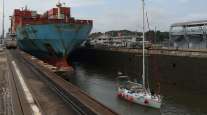CN Rail, BNSF Tackle Accidents as Group Seeks Ban on Oil Trains

Canadian National Railway Co. is building a 1,500-foot long track to bypass a burning train that derailed March 7 in northern Ontario, while BNSF Railway Co. crews are working to reopen track in rural Illinois after a train carrying oil derailed March 5.
CN crews teamed with outside specialists are fighting the blaze after an eastbound train carrying crude oil derailed and caught fire around 2:45 a.m. near Gogama, about 600 kilometers north of Toronto, cutting off rail traffic between Toronto and Winnipeg, Manitoba.
The BNSF train jumped the tracks March 5 near Galena, Illinois, about 160 miles west of Chicago, according to the railroad, a unit of Warren Buffett’s Berkshire Hathaway Inc.
The accidents bring to four the number of oil train wrecks in North America in the past three weeks, according to the Center for Biological Diversity. The environment group is calling for a halt to transport of oil by rail, which has surged since 2009 with the boom in crude production from shale.
“We need a moratorium on oil trains,” Mollie Matteson, a senior scientist at the center, which has fought to protect wildlife for 26 years, said in a March 7 statement. “The oil and railroad industries are playing Russian roulette with people’s lives and our environment.”
The BNSF train was carrying oil from North Dakota’s Bakken shale formation for Mercuria Energy Group Ltd. Twenty-one of the train’s 105 cars, which include two sand cars as buffers, jumped the tracks Thursday afternoon.
The U.S. Department of Transportation said 14 cars were in a pileup and half of those were punctured. Emergency responders evacuated a 1-mile radius, which contained six homes. No injuries have been reported.
BNSF plans to reopen its mainline track March 9, Mike Trevino, a spokesman for the railroad, said in a phone interview.
North American oil producers have increased their reliance on rail as new pipelines failed to keep pace with a surge of production from shale. The typical rail car carries about 700 barrels of oil, according to data posted on BNSF’s website. The number of oil carloads rose more than 40-fold from 2009 through 2013, when 435,560 carloads were shipped, and kept climbing last year to an estimated 500,000, according to the Association of American Railroads.
The CN derailment damaged a bridge over a waterway as five tank cars ended up in the water, with some of them on fire, the Montreal-based railway said in a statement. Crews have placed three lines of booms on the river to contain the crude. Drinking water supplies to Gogama Village and a nearby Mattagami First Nation community are not affected, CN said.
“Fire suppression activities will begin later today,” spokesman Jim Feeny said in an e-mailed statement. “Residents will likely see occasional smoke plumes of various shades of black, gray or white. This is expected, normal, and poses no threat to the public or the environment.”
The railcars, carrying crude oil from Alberta, are CPC-1232 models railroads began to roll out in 2011 to boost safety.
The accident marks the second derailment of a CN oil train in three weeks near Gogama. A train with 100 cars, all laden with crude from Alberta bound for eastern Canada, derailed on Feb. 14 about 30 miles north of the town. A total of 29 cars were involved in that incident and seven caught fire, a spokesman said at the time.
Investigators from the Transportation Safety Board of Canada are on site, which is 37 kilometers from the previous accident, agency spokesman John Cottreau said March 8 by phone. The train was headed to Levis, Quebec, when 30 to 40 cars derailed.
“Billions of gallons of oil pass through towns and cities ill-equipped to respond to the kinds of explosions and spills that have been occurring,” according to the Center for Biological Diversity. “Millions of gallons of crude oil have been spilled into waterways.”




